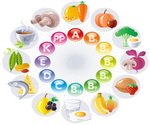|
Vitamins In Food – How Can We Get All That We Need?Vitamins in food are key nutrients that we get from our food and that play vital roles in how our bodies function for optimum health; however, if we don’t engage in proper nutrition we can’t get the vitamins that we require. When this happens many people choose to use supplements. Others may be getting enough of these nutrients in their diets but choose to add a little something extra, is that wise? Still others think of them as a cure all for many different diseases, is that true? By taking a look at these nutrients and what their role is in the body, then it is possible to make more informed decisions about what foods you need to eat to get what is needed and whether or not to take supplements. There are some important differences between vitamins from other nutrients such as carbohydrates, fats, and proteins. One of those differences is that they are only required in microgram quantities unlike carbohydrates, fats and proteins which are required by the body in gram quantities. In addition, unlike carbohydrates, fats and proteins, they are not an energy source; however, they do play key roles in regulating chemical reactions that make it possible for our bodies to extract energy from carbohydrates, fats, and proteins. Another difference is that unlike carbohydrates, fats, and proteins, vitamins are different in their structure, being single units instead of long chains of smaller units. Like carbohydrates, fats, and proteins they are organic, meaning carbon containing compounds which are essential for life. We are as one popular science fiction program of the 1960’s put it, carbon based units; therefore, along with carbohydrates, fats, and proteins, vitamins are essential for the normal growth, functioning and maintenance of the body. The two basic forms of vitamins in food are, fat soluble and water soluble. Those that are fat soluble are lipid-like molecules that are soluble or dissolve in fat. Those that are water soluble are easily dissolved in water. Whether a vitamin is fat or water soluble determines how it is absorbed, transported and stored by the body.
Digestion in the stomach and small intestine is what releases vitamins from the food that we eat. After digestion they are absorbed either by the water soluble or fat soluble process. Absorption by the body is through the intestinal tract cells and delivered directly to the blood stream for those that are water soluble with the kidneys filtering out the excess water soluble vitamins and excreting the excess in the urine. For those that are fat soluble they are absorbed with fats and transported by way of the lymph to the blood stream where they eventually make their way to the liver either to a storage depot in the liver for indefinite storage as well as storage in adipose (fat) tissue until they are needed or for repackaging for shipment to other tissues. The problem arises with fat soluble vitamins such as Vitamin A and Vitamin D which if they exceed the body’s storage capacity can become toxic to the body, which is why it is important to know about these vitamins in food and other vitamins to avoid doing harm to the body by taking in amounts of certain of these nutrients in excess of what is needed. Usually it is harmless to consume an excess of these nutrients that are water soluble, with the exception of Vitamin B6, folate, niacin, and sometimes Vitamin C, especially when mega doses of these nutrients are consumed, since consuming them in food or in supplements that contain only 100 -150% of the recommended dosage is not a problem. What comprises each group of vitamins in food? Fat Soluble Vitamins Water Soluble Vitamins Once in the body there are some major roles for vitamins. What are some of those roles? Some act as antioxidants – Vitamin E and Vitamin C; coenzymes – the B vitamins; bone health – Vitamin D and Vitamin K; vision – Vitamin A; and blood clotting – Vitamin K. Food Sources Good food sources of vitamins are fruits, vegetables, and grains. It should be noted that the more foods are processed and cooked, the more these nutrients are lost, but there are ways of cooking that can help to retain these nutrients longer and more intact (stay tuned for more information about ways to retain nutrients in food).
For other information on nutrition including vitamins in food some great references are: • Nutrition – Fourth Edition by Paul Insel, Don Ross, Kimberley McMahon, and Melissa Bernstein
Cooking Recipes
|
Vitamins

Once in the body there are some major roles for vitamins. What are some of those roles?
Some act as:
Antioxidants – Vitamin E and Vitamin C
Coenzymes – B vitamins
Bone Health – Vitamin D and Vitamin K
Vision – Vitamin A
Blood Clotting – Vitamin K





